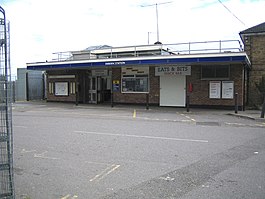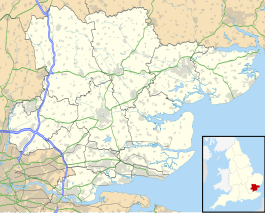
Rayners Lane is a London Underground station in the district of Rayners Lane in north west London, amid a 1930s development originally named Harrow Garden Village. The station is on the Uxbridge branch of both the Metropolitan and Piccadilly lines. On the Metropolitan line, the station is between Eastcote and West Harrow stations. On the Piccadilly line, it is between Eastcote and South Harrow stations. The station is located to the west of the junction of Rayners Lane, Alexandra Avenue and Imperial Drive (A4090). It is in Travelcard Zone 5. Just east of the station, the Piccadilly and Metropolitan lines tracks join for services to Uxbridge and separate for those to Central London.

Leyton is a London Underground station in Leyton, in the London Borough of Waltham Forest, East London. Located on Leyton High Road, adjacent to the A12, the station is on the Central line between Stratford and Leytonstone stations. It is in Travelcard zone 3.
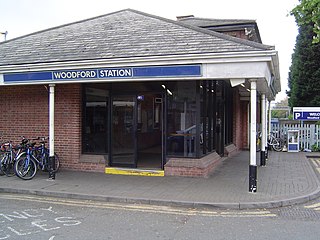
Woodford is a London Underground station in the town of Woodford in the London Borough of Redbridge, East London. The station is on the Central line, between South Woodford and Buckhurst Hill stations and is in Travelcard Zone 4. The station also acts as a terminus for services via the Hainault loop.

Ruislip is a London Underground station in Ruislip in west London. The station is on the Uxbridge branch of both the Metropolitan and Piccadilly lines, between Ickenham and Ruislip Manor stations. The station is located on Station Approach. It is in Travelcard Zone 6. It is the oldest station on the Uxbridge branch and was originally the only intermediate station on the line between Uxbridge and Harrow-on-the-Hill.

South Harrow is a London Underground station in South Harrow, north-west London. It is on the Uxbridge branch of the Piccadilly line between Rayners Lane and Sudbury Hill stations. It is located on Northolt Road (A312). The station is in Travelcard Zone 5. There are several bus stands outside the station as well as overnight train stabling sidings.

Leytonstone is a London Underground station in Leytonstone in the London Borough of Waltham Forest, east London. It is on the Central line, on the boundary of Zones 3 and 4. Towards Central London, the next station is Leyton, while going east from Leytonstone, the line divides into two branches. On the direct route to Woodford and Epping the next stop is Snaresbrook, and on the Hainault loop it is Wanstead. The station is close to Whipps Cross University Hospital. It is a terminus for some services and returns westbound.

Loughton is a station on the Central line of the London Underground, serving the suburban town of Loughton in the Epping Forest District of Essex. It lies between Buckhurst Hill and Debden, in Travelcard Zone 6. The station is entirely above ground, and platforms are accessed by staircases which rise from ground level.

Snaresbrook is a London Underground station on the Central line, located in the area of Snaresbrook in East London. The station is in Zone 4, between Leytonstone and South Woodford stations.

West Ruislip is a station on Ickenham High Road on the borders of Ickenham and western Ruislip in the London Borough of Hillingdon in Greater London, England, formerly in the county of Middlesex. It is served by London Underground (LU) and National Rail trains on different platforms. It is the western terminus of the London Underground Central line's West Ruislip branch; Ruislip Gardens is the next station towards central London. The Central line and Chiltern Railways platforms and ticket office hall are managed by LU. The closest station on the Metropolitan and Piccadilly lines is Ickenham, 1.1 miles (1.8 km) from West Ruislip Station.

Northolt is a station on the London Underground Central line in Northolt in the London Borough of Ealing. It is in Travelcard Zone 5 and between Greenford and South Ruislip stations.

Greenford is a London Underground and National Rail station in Greenford, Greater London, and is owned and managed by London Underground. It is the terminus of the National Rail Greenford branch line, 2 miles 40 chains down the line from West Ealing and 9 miles 6 chains measured from London Paddington. On the Central line, it is between Perivale and Northolt stations while on National Rail, the next station to the south on the branch is South Greenford.

Epping is a London Underground station in the suburban town of Epping in Essex, England. The station serves as the north-eastern terminus of the Central line. Located in Travelcard Zone 6, it is one of eight London Underground stations in the Epping Forest District. The station before Epping is Theydon Bois, which is about three minutes' travelling time away.
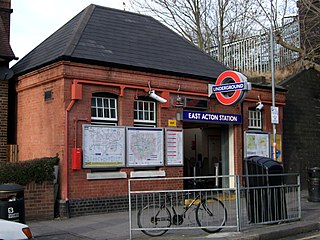
East Acton is a London Underground station in East Acton in London Borough of Hammersmith and Fulham. The station is on the Central line, between White City and North Acton stations, and in Travelcard Zone 2. Wormwood Scrubs, Queen Charlotte's and Chelsea Hospital, Hammersmith Hospital, Wormwood Scrubs prison and Imperial College Hammersmith branch are accessible from the station.

South Woodford, originally George Lane, is a London Underground station in the suburb of South Woodford in East London. It is on the Epping branch of the Central line, between Snaresbrook and Woodford stations and is in Travelcard Zone 4.

Theydon Bois is a London Underground station in the village of Theydon Bois in Essex, England. It is served by the Central line and is between Debden and Epping, in Travelcard Zone 6.

East Putney is a London Underground station in Putney in the London Borough of Wandsworth. It is on the Wimbledon branch of the District line, between Putney Bridge and Southfields, and is on the boundary between Travelcard Zones 2 and 3. The entrance to the station is on Upper Richmond Road (A205).

Parsons Green is an above-ground London Underground station on the Wimbledon branch of the District line that opened in 1880. It is between Fulham Broadway and Putney Bridge stations and is in Zone 2. There are entrances on Parsons Green Lane and in Beaconsfield Walk. The station is a short distance north of the green itself. It was previously a train-operator depot, until functions were transferred to Earl's Court.
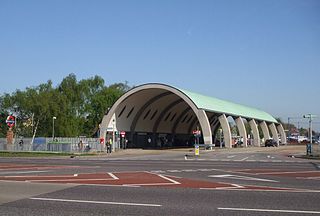
Newbury Park is a London Underground station in Newbury Park, Ilford, East London. It is between Barkingside and Gants Hill stations on the Hainault loop of the Central line, in Travelcard Zone 4. The station was initially opened by the Great Eastern Railway on 1 May 1903 and subsequently transferred its services to the London and North Eastern Railway due to the amalgamation. Underground trains only started serving the station on 14 December 1947, operating via the Gants Hill tunnel. The line was extended to Hainault on 31 May 1948. The Grade II listed bus shelter designed by Oliver Hill opened on 6 July 1949. Lifts were fully installed at Newbury Park in November 2018 to provide step-free access to the station, approximately 10 years after TfL abandoned the project.

Fairlop is a London Underground station in Fairlop in east London, England, which is on the Central line of the London Underground. It has been in Travelcard Zone 4 since 2 January 2007. It is on the north side of Forest Road, in Fairlop, just north of Barkingside.

Chigwell is a London Underground station in the town of Chigwell in the Epping Forest district of Essex. It is located on the Hainault Loop of the Central line, between Grange Hill and Roding Valley stations.
